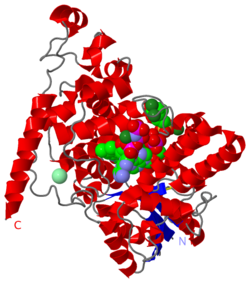JMS/sandbox22
From Proteopedia
(Difference between revisions)
| Line 19: | Line 19: | ||
Researchers Klaus Schulten at University Illinois at Urbana Champaign and Ilya Solov'yov, now at the University of Southern Denmark, connect this system to the fascinating ability of many birds, and other flying species, to migrate while sensing the earth's magnetic field. Through simulations, they show that where the bird's cryptochrome compass's "FAD-trp324 needle" is aligned with the line extending between the poles, the entangled electrons will 'on average' spend more time in the same spinning state (also known as triplet; or parallel), and therefore by delaying the electrons return to trp324, FAD will 'on average' be in its signalling mode for longer. | Researchers Klaus Schulten at University Illinois at Urbana Champaign and Ilya Solov'yov, now at the University of Southern Denmark, connect this system to the fascinating ability of many birds, and other flying species, to migrate while sensing the earth's magnetic field. Through simulations, they show that where the bird's cryptochrome compass's "FAD-trp324 needle" is aligned with the line extending between the poles, the entangled electrons will 'on average' spend more time in the same spinning state (also known as triplet; or parallel), and therefore by delaying the electrons return to trp324, FAD will 'on average' be in its signalling mode for longer. | ||
| - | Mechanistically, the propensity of the electrons to spin in one direction of the other is affected by a local magnetic field, which is in this case primarily determined by the nuclear spins of several key nitrogen and hydrogen atoms, | + | Mechanistically, the propensity of the electrons to spin in one direction of the other is affected by a local magnetic field, which is in this case primarily determined by the nuclear spins of several <scene name='58/585079/1u3d_magnet/22'>key nitrogen and hydrogen atoms</scene>, |
Because many cryptochrome proteins are invovled in registering blue light photons - millions of proteins per cell, and many cells across the retina, a change in the average time spent in the signalling state is perhaps measured by the brain as the time until 50% of the cells do not have active FAD molecules. By | Because many cryptochrome proteins are invovled in registering blue light photons - millions of proteins per cell, and many cells across the retina, a change in the average time spent in the signalling state is perhaps measured by the brain as the time until 50% of the cells do not have active FAD molecules. By | ||
Revision as of 19:34, 4 August 2014
| |||||||||||
References:
- Cryptochrome and Magnetic Sensing, Theoretical and Computational Biophysics Group at the University of Illinois at Urbana-Champaign

